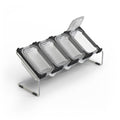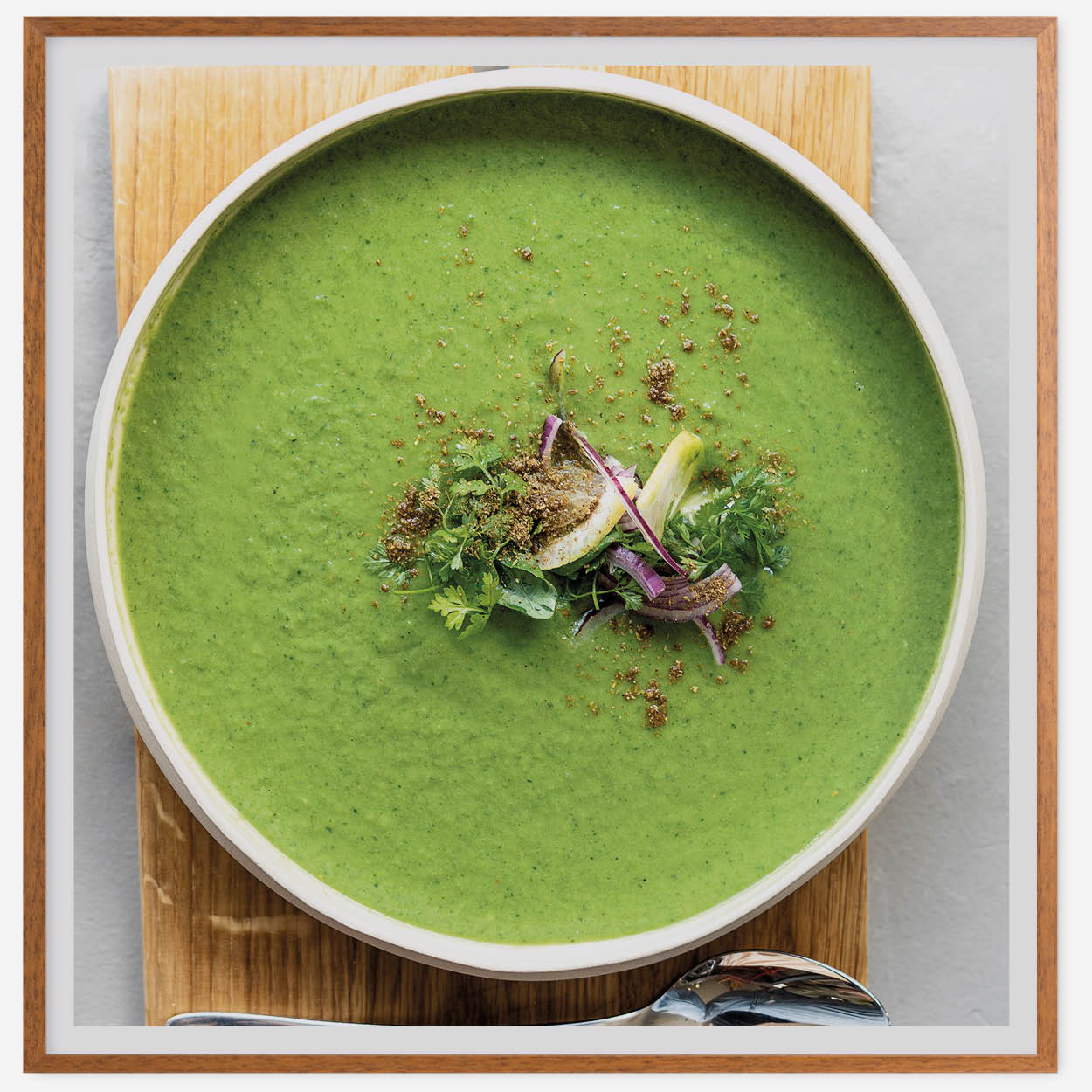THE BRETT SESSIONS | VOL. 01
OUR culinary HEARTBEAT.
by the stove
on the stove
Joseph & Johannes Schreiter
TEAM FRANKFURTER BRETT
the perfect Jus
Baked tomatoes
Lasagna Ricicleta
Jus.
(Spoken: SHÜÜÜÜ. [ʒy] With a french J at the beginning, like in jalousie or journal.)
+
That fragrant, creamy, golden-brown essence that you only ever get in fancy restaurants or at Christmas and which is usually the best part of the whole meal.
But it is not the classic dishes like roulades or really sophisticated things that we primarily associate with jus - quite the opposite:
It is the relaxed dipping, finger-licking and uncomplicated enjoyment at the end of an heart warming evening, which is what jus is all about for us and which is why we have also made it the focus of our recipe with crispy Parmesan bread, a generous bowl of jus for dipping and a portion of oven tomatoes:
The jus is unrivaled the star of the evening with all its finesse, people eat with their hands and feet and everyone chews slowly with their eyes closed, because everything fits together perfectly here.
NOTHING SHORT OF AMAZING..
Enjoyed ideally in the evening on the summer-warm balcony with vermouth or ice-cold white wine.
The complete recipe for our heart-warming afternoon including baked tomatoes and a bit of kitchen table philosophy on the social-revolutionary component of gravy can be found below.
LASAGNA RICICLETA
Traditionally, the basis for a jus is a large pile of roasted vegetables, which are usually thrown away after boiling - something that has always been a nuisance. This also makes the purchase really expensive, when "only" 1.5 litres of pure jus are produced.
This time we just did the obvious - a quick lasagne. But without a real recipe, because what makes this lasagne special is the roasted vegetables, which are already there. A few notes about the lasagne as a hint can be found at the end of the jus recipe.
We wish you a lot of fun trying it out!
Joseph & Johannes-
The perfect jus.
//LUXURY FOR EVERYONE
In our culinary world, good jus is as significant as only caviar, champagne, oysters or food of exceptional quality can be. However, jus - and this makes it very special in the group of the luxury goods listed above - cannot actually be purchased and has to be produced by yourself.
Therefore it takes a democratic place of honour in the realm of culinary extravagances:
Jus is luxury for everyone, because anyone can cook jus. All it takes is time, dedication, vegetables, red wine & spices. You just simply have to be worth the effort to yourself.
-
LUXURY RESERVE
It has proven to be particularly enriching for us in everyday life to have a glass of good jus in the refrigerator, at the latest when a surprise visit is coming, which one wants to impress with an informal but nevertheless sophisticated dish or simply as a small luxury reserve on demand.
A glass of Everyday Jus takes boring sandwiches to a whole new dimension, just as any simple meal per se is enhanced - whether it's simple boiled eggs with fresh herbs, a hangover breakfast on Sunday with eggs and bacon, a classic mushroom omelette or simple fried potatoes with gherkins.
A few spoonfuls of gravy on top and an ordinary everyday moment turns into an explicit pleasure moment with style.
-
GRAVY?
Our recipe is not vegan by accident - we developed it when we were still working in the MARGARETE in Frankfurt (the restaurant of Raffaela Schöbel and Simon Horn, in which, by the way, the FRANKFURTER BRETT started back then and in whose kitchen we developed the first prototypes) and cooked a vegan menu evening. When "vegan" was still new - 2014.
A guest at that time had awakened our ambition by saying that vegan food can never be perfect because there can be no good vegan jus.
Even though we haven't been vegan for a long time, this recipe is still our taste reference when it comes to jus - there's simply nothing missing.
If you like to use bones and meat, just roast it along the vegetables in the beginning and also add it back into the hob when boiling.
- THE BRETT-SESSIONS | VOL.25
- „THE PERFECT JUS"
for approx. 1.5 litres
------
- 3 BOTTLES OF RED WINE
- 1 LITER OF WATER
- 1 BUNCH OF SOUP GREENS (CARROT, CELERY,
- LEEK, PASTINAKE), COMPLETELY DICED
- 200G MUSHROOMS, DICED
- 200G SHITAKE, DICED
- 1 LARGE VEGETABLE ONION
- 300 G SMOKED TOFU
- 1 SMALL BUNCH OF PARSLEY, STALKS FINELY CHOPPED,
- LEAFS PLUCKED
- 3-4 BAY LEAVESr
- 5 JUNIPER BERRY
- 2 LARGE CLOVES OF GARLIC
- AS MUCH GINGER
- 1 BRANCH ROSEMARY
- 2 TWIGS THYME
- 1 HANDFUL OF OREGANO
- 6 LEAVES OF FRESH SAGE
- 1 TSP CUMIN
- 2-3 STAR ANIS
- 2 EL GREEN PEPPER
- 1 TABLESPOON OF MUSTARD
- 3 TABLESPOONS OF SOJASAUCE
- 0,5 TUBE TOMATO PASTE
- 5 TABLESPOONS PLUM JAM
- SOME STARCH TO SET
- 150 G BUTTER, DICED AND COOLED (TO MOUNT THE SAUCE)
STEPS
1 - Dice the roasted vegetables, mushrooms, shitake and the onion.
2 - Let the pot get hot, with a little oil, and add half of the diced roasted vegetables and mushrooms. It is important to roast the vegetables as much as possible in a controlled way, they may become quite black in places.
Therefore
The bottom of the pot should be just covered with the vegetable cubes
Leave the vegetable cubes for the time being, carefully check the roasting progress.
When it is brown enough, stir once to let the cubes take colour from another side then pour the vegetables into another container and repeat with the rest of the vegetable dices.
3 - When the pot is empty after the last roast, add some red wine, let it boil up and scrape the burnt residue from the bottom of the pot with a spatula, using sufficient force. These residues and the browning of vegetables and meat later give the whole dish its dark colour and strong roasting aromas. Meanwhile, there should not be too much wine in the pot - otherwise the scratching movements can easily cause too much undulation, danger of burning and flooding. As soon as the bottom of the pot is reasonably clean again, the roasted vegetables are put back into the pot.
4 - Add the rest of the wine, tomato paste, plum jam, mustard and soy sauce to the pot. Simply crumble the smoked tofu by hand in the pot.
5 - All the spices and herbs, the garlic, ginger and the parsley stalks either hang in a sieve in the pot or mix to a paste and stir in. If the roasted vegetables are used further, you should not have to bite on star anise capsules.
6 - The whole thing should then simmer gently for at least an hour. It is best to place a lid on top of it slightly offset so that the valuable sauce does not evaporate too much.
7 - At the end of the cooking time, place the vegetables in a sieve over a pot and drain the sauce. Then put the vegetables back into the pot, pour the water over them, stir once and put them directly back into the sieve above the pot. This way you have rinsed the rest of the sauce from the vegetables.
Put the vegetables covered in the fridge, put the pot back on the flame. Season the sauce with salt, soy sauce and a little sugar until it tastes smooth. Then thicken with starch until it is thick enough to taste.
Shortly before serving, mix in some cold butter and serve with Parmesan toast (here with oregano and young garlic) for dipping and baked tomatoes. And cold beer.
NOTES
A jus is a highly intense and concentrated, velvety, thick liquid sauce based on red wine, with rich roast aromas and a whole bouquet of spice and herb aromas.
In this version we use a lot of fresh mushrooms for a proper umami and a wide chest taste wise. Of course you can use other mushrooms, or dried shitake or porcini mushrooms.
Actually, you can put a lot of things into a jus that have been in the pantry for a long time and are too good to throw away, but never really get the hungry cook's attention at the right moment.
Smoky taste also goes well with it. We have used smoked tofu here, but bacon or smoke flavor does of course do the trick just as well.
Plum jam, tomato paste, mustard and soy sauce create a bond and a hearty base tone and bind all tastes nicely into a dense, warm, sluggish dripping bowl of happiness.
Shortly before serving, one classically mixes a few cubes of cold butter into the sauce, which becomes even creamier and fatter - as do the eaters, of course.
-
We want to continue using the vegetables for the lasagne, so we made sure that all the seasonings, i.e. herbs, garlic, ginger and spices in a sieve can release taste in the sauce in a controlled manner, but can also be easily removed afterwards.
(You can also put everything together in a blender and make a kind of fine spice paste and stir it into the sauce. This is even better, but we thought of it too late. To be honest.)
Baked tomatoes
// SPICY-SWEET. UNBEATABLY DELICIOUS. AND SO DAMN EASY.
Oven tomatoes - one of our absolute classics. They are a derivation of classic confit tomatoes, which are left to stand for several hours at 100 degrees with plenty of oil and spices. Our version relies on brutal heat, lots of caramelized sugar and our by now very finely balanced spice mixture, which also gets strong roasting aromas.
Garlic, rosemary and thyme float in the oil under the tomatoes and give off a taste to the oil, which can be dipped up afterwards very well with bread or can be processed to a salad dressing. The tomatoes taste best when lukewarm, with toasted brown bread, in a salad or as a great side dish to almost anything.
Salt and sugar are sprinkled as evenly as possible over the tomatoes like seeds - the quantities may seem rather dubious at first glance, but have proved absolutely reliable. The result is an intense, warm, sweet tomato that melts in your mouth and has tasted exceptionally good to everyone.
Almost the most beautiful aspect is the supposed NON-spectacle when the baked tomatoes are first served - and the almost ecstatic reactions to the first bites. Understatement at its best.
- THE BRETT-SESSIONS | VOL.25
- „BAKED TOMATOES"
freely scalable
------
- 1 KG OF TOMATOES
- 500 ML GOOD OLIVE OIL OR OTHER
- PLANT OIL
- 15 G SUGAR
- 7 G SALT
- 1 EL NIGELLA (BLACK CUMIN, GROUND)
- 1 EL FENNEL SEED, GROUND
- ½ CINNAMON
- ½ TBSP. PEPPER
- ½ EL CUMIN
- 1 GARLIC BULB
- 3 TWIGS ROSMARINE
- ½ BUND THYME
STEPS
1 - Preheat the oven to 250° convection.
2 - In the meantime, remove the stalk from the tomatoes and cut them into sixths.
3 - Then mix the tomato slices with the vegetable oil in a large bowl.
4 - Flatten the garlic cloves with the broad side of the knife and place them on a baking tray with rosemary and thyme.
5 - If necessary, pound the dry spices together in a mortar or - very useful purchase - use a small electric coffee grinder.
6 - Now place the oiled tomatoes, skin side down, on the baking tray lined with garlic and herbs, sprinkle the spice mixture, as well as salt and sugar evenly over them and roast in the oven for about 25 minutes. If the oven offers an exhaust function, then switch it on, so the tomatoes dry and intensify even more. If not, you can ventilate the tomatoes from time to time by opening the oven door.
7 - The tomatoes should be strongly burnt. When the time has elapsed, open the oven carefully and take out the baked tomatoes to cool down. They taste best lukewarm, so if they are not immediately consumed, give them some time to temper after storing them in the refrigerator. These tomatoes are also a great side dish with hummus & bread, or with pasta instead of sauce.
NOTES



- THE BRETT-SESSIONS | VOL.25
- „LASAGNA"
LASAGNE WITH "RECYCLED" VEGETABLES
Actually, a combination that couldn't be more beautiful:
First, standing in the kitchen for hours on a Saturday during the day, letting your soul dangle by producing jus, and then on Sundays cooking your family or friends from the leftovers of the jus into the ultimate lasagne heaven with 5 quick touches.
The recipe below is relatively loosely knitted - lasagne is actually something anyone can make and accuracy is not really important. The béchamel requires a little effort, but the important thing is the roasted vegetables and that's already done the day before.
IMPORTANT: Cover the finished lasagne with aluminium foil for baking and only uncover it at the end.This way you can gratinate the cheese au point - nice brown and crispy in places, but also very juicy and stringing.
1 - Stretch the roasted vegetables of the jus with canned tomatoes and season with salt & pepper.
2 - Make a classic béchamel - melt butter in a pot and dust with flour until all the fat is bound. Let the flour mixture sweat a little, stirring constantly with whisk. Then gradually add milk.
We still had fresh herbs left over from the day before and boiled up a kind of " herbal tea" (in this case thyme, rosemary, sage, oregano, laurel), thus giving the béchamel sauce, which is actually rather bland, a nice twist. Simply replace a part of the milk with "tea".
3 - Season to taste with salt, pepper and nutmeg and bring to the boil once.
4 - Stack the lasagne in an oven dish, starting with a layer of béchamel sauce. Then lasagne sheets, followed by tomatoes, then zucchini slices, then lasagne sheets. Repeat until all ingredients are used up.
5 - Place the cheese of your choice on the top layer of lasagne sheets.
We have used Scarmoza, Mozzarella, Parmesan and Taleggio - it is recommended, but you can do almost nothing wrong.
6 - Cover the lasagne with aluminium foil. This allows the lasagne to cook through without burning the cheese layer.
7 - Put the lasagne in the oven at 180° C for 20 minutes.
8 - Remove aluminium foil, gratinate lasagne for another 15 minutes with top heat
recipe: JOHANNES & JOSEPH SCHREITER | photography & VIDEOS: FRANKFURTER BRETT GmbH
by the stove
+
JOSEPH & JOHANNES SCHREITER |
Johannes cooks, und Joseph writes
.
We the eat together.
Everyone what he can do best.























